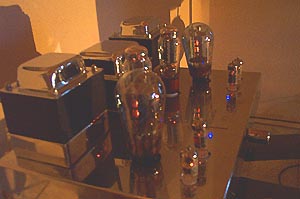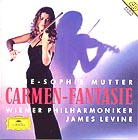 |
||||||||
|
The Art Audio 6-watter, back again on the German HMS cables, niched itself immediately between the eVo and AUDIOPAX but nestling far closer to the Brazilian duo. Think of Joe Fratus' creation as a somewhat lighter version of the series-parallel pentode amp. It's harmonically not quite as developed, especially when the Brazilians are TimbreLock'd for maximum glow without overshooting into thick. The twin KT88s give more heft down low even though the chromed champ from Rhode Island isn't exactly a slouch in that department. Soundstage depth with the PX-25 seemed particularly gargantuan while the twins' midband added a few degrees of palpability to vocals that even the 1940's bottle reissued by KR Audio couldn't match. |
||||||||
|
The basic leanness of the Victories still remained. Do you begin tiring by suspecting that I'm unfairly criticizing a speaker for deliberately forgoing full-range status? I'm not. My Triangles don't do the very lowest bass either. I do, however, perceive a potentially weak heel for Achilles the Victor - what seems to be a noticable rise somewhere in its 1-3kHz crossover regions.
By now I started to wonder. Did Israel Blume's familiarity with 300B and 2A3-type amplifiers exclude admittedly rarer beasts whose treble linearity, like mine, extends to 60 or even 90kHz? Most amps using classic low-power triodes exhibit midrange ripeness and a certain ponderousness of mien. |
||||||||
 |
||||||||
|
For such mates, the Victory lift might in fact be the perfect antidote, to inject much-needed air, sparkle and motility to cancel out some of these designs' inherent liabilities. While by no means capable of provoking a clear-cut answer either way, I now pulled my Jolida JD-100 tubed CD player and Art Audio VPS-dm valved preamp from the living-room system. Would multiple tube stages in series inject enough thermionic frequency/harmonic spectrum qualities to perhaps mimic more traditionally-voiced low-power SETs?
In a word, yes! Because neither of these devices suffers any obvious treble roll-off or excessive midrange girth when inserted one at a time into my reference rig, the clear reshuffling of the sonic board now indicated that a combination of compounded harmonics shifted the overall audible balance. The Art Audio preamp -- without the Jolida but my usual Cairn CD player as front-end, itself replacing the solid-state Bel Canto PRe1 -- added what I've come to recognize as its signature: Heightened dynamics, spectacular layering and a fair slice of timbral saturation, but (especially in the context of a high-rez rig) also a small loss of final resolving power and a minor reduction of perceived transparency. That small clouding coupled to deeper tonal colors proved a vital step in the right direction. Adding the tubed Jolida finally spelled coming home. The bass got plumper, the midrange more voluptuous. Resetting those parameters now indirectly affected the top as well. It retained its sparkly, open and airy dimensions but no longer suffered a trace of bite or cold-hearted incisiveness. Case in point? |
||||||||
|
The stupendous Mutter recording of Sarasate's "Carmen Fantaisie" [Deutsche Grammophone 437-544-2, with the Vienna Philharmonic under James Levine]. The massive footfall of the heavily portentous orchestral opening theme now befitted the score - the difference of apparent displacement between a punching bag hit by a bantam weight and a professional harbor slugger. Mutter's violin, even into extreme flageolet or Tzigane-style spiccato, had fullness and burnished elegance of tone, any former flirtations with stridency or steeliness forgotten. Properly weighted, now the speakers' already itemized assets began to assume their rightful position below the canopy of correctly centered tonal balance. I'd become the happy camper I assume Israel Blume had in mind all along when soliciting this review. Coincidently -- pun by pure happenchance -- the amps under his own brand are paralleled 18-watt 300B designs with 5AR4 rectifiers. Suddenly things began to make sense.
|
||||||||
 |
||||||||
|
Sunset commentary While I can't be sure, I wager a bet. The inherent voicing of the Coincident Speaker Technology VIctory speaker was designed to primarily complement low-power tube amps of more traditional response than my own reference units which, in many respects, are rather anti-valve. Once I had unwittingly accounted for that possiblity, the fog of consternation evaporated. Now I could relate. And I bet you could, too.
We would to thank Srajan for the time and effort he applied to the review of the Victories. Due to their amazing resolution and purity, a reviewer is compelled to re-examine his associated components, room and overall system set up, all of which is very time-consuming. |
||||||||
 |
||||||||
 |
||||||||
|
Manufacturer's website
|
||||||||
 |
||||||||